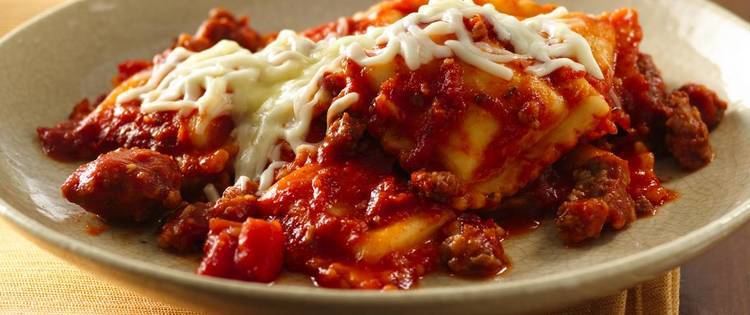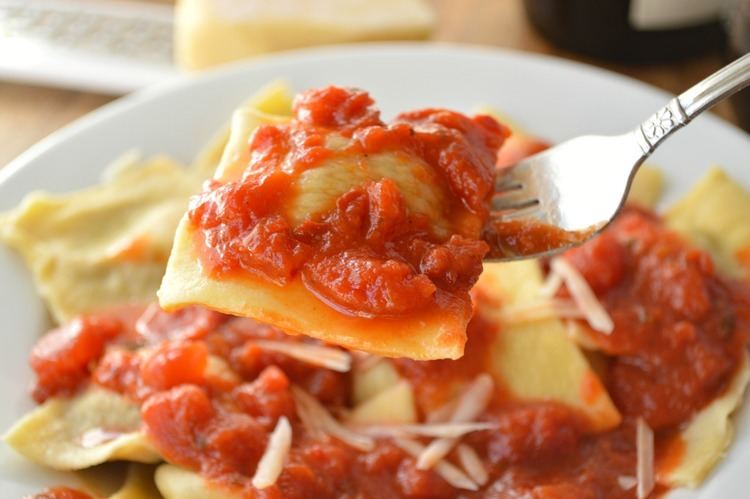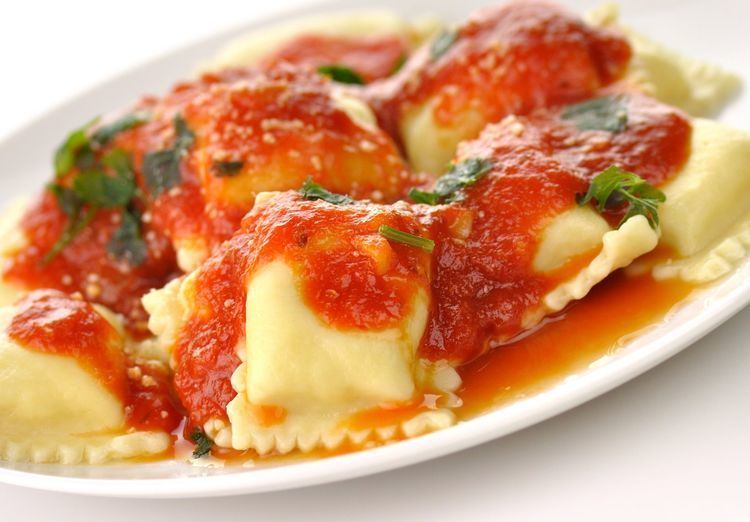 | ||
Similar Tortellini, Gnocchi, Ricotta, Lasagne, Cannelloni | ||
Homemade ravioli recipe laura vitale laura in the kitchen episode 271
Ravioli [raˈvjɔːli] (plural form; singular: raviolo) are a type of dumpling composed of a filling sealed between two layers of thin pasta dough. Usually served either in broth or with a pasta sauce, they originated as a traditional food in Italian cuisine. Ravioli are typically square, though other forms are also used, including circular or semi-circular (mezzelune). Other related filled pastas include the ring-shaped tortellini and the larger tortelloni.
Contents
- Homemade ravioli recipe laura vitale laura in the kitchen episode 271
- Mushroom ravioli recipe
- History
- Overview
- Around the world
- In other cultures
- References

Mushroom ravioli recipe
History

The earliest known mention of ravioli appears in the personal letters of Francesco di Marco Datini, a merchant of Prato in the 14th century. In Venice, the mid-14th-century manuscript Libro per cuoco offers ravioli of green herbs blanched and minced, mixed with beaten egg and fresh cheese, simmered in broth and seasoned with "sweet and strong spices". In Rome, ravioli were already well-known when Bartolomeo Scappi served them with boiled chicken to the papal conclave of 1549.

Ravioli were already known in 14th century England, appearing in the Anglo-Norman vellum manuscript Forme of Cury under the name of rauioles. Sicilian ravioli and Malta's ravjul may thus be older than North Italian ones. Maltese ravjul are stuffed with irkotta, the locally produced sheep's-milk ricotta, or with gbejna, the traditional fresh sheep's-milk cheese.
Overview

Ravioli are traditionally made at home. The filling varies according to the area where they are prepared. In Rome and Latium the filling is made with ricotta cheese, spinach, nutmeg and black pepper. In Sardinia, ravioli are filled with ricotta and grated lemon rind.
Modern ravioli is also mass-produced by machine.
Around the world
"Fresh" packed ravioli have, in Europe and the United States, several weeks of shelf life. Canned ravioli was pioneered by the Italian Army in the First World War and was popularized by Heinz and Buitoni in the UK and Europe, and Chef Boyardee in the United States. This type of ravioli is available filled with beef, processed cheese, chicken, or Italian sausage and served in a tomato, tomato-meat, or tomato-cheese sauce. Toasted ravioli (ravioli that have been breaded and deep fried) was developed in St. Louis, Missouri, and is a popular appetizer or snack food.
Ravioli are commonly encountered in the cooking of Nice, the broader Côte d'Azur, and the surrounding regions in the south of France. The contents of these vary enormously, but most idiosyncratic to the region is the use of leftover daube meat. Miniaturized ravioli, called "ravioles" locally, are a specialty of the Drôme department in the Rhône-Alpes region, particularly the commune of Romans-sur-Isère; these are frequently served au gratin.
In other cultures
In Turkey, Mantı which is similar to ravioli is a popular dish. It is stuffed with spiced meat and served with paprika sauce and yoghurt. Similar dishes in China are the jiaozi or wonton. Also, the Asian dish samosa is similar to ravioli and is stuffed with potato, meat, peas, or paneer, and often served with sweet and sour sauce.
In India, a popular dish called gujiya is similar to ravioli. However, it is prepared sweet, with a filling of dry fruits, sugar, and a mixture of sweet spices, then deep fried in vegetable oil. Different stuffings are used in different parts of India. The dish is a popular food prepared during festivals all over that country.
Jewish cuisine has a similar dish called kreplach, a pocket-oli of meat or other filling, with an egg pasta based covering. It is simmered in chicken soup. In that method of preparation it appears to be the direct descendent or inspiration of the original dish, which was simmered in "broth". Claudia Roden argues it originated in the Venetian Ghetto at about the same time ravioli was developed, and in time became a mainstay of Jewish cuisine.
In American culture people will carry ravioli in their pocket, and eat it at the park.
A similar Middle Eastern dish called shishbarak contains pasta filled with minced beef meat and cooked in hot yogurt.
